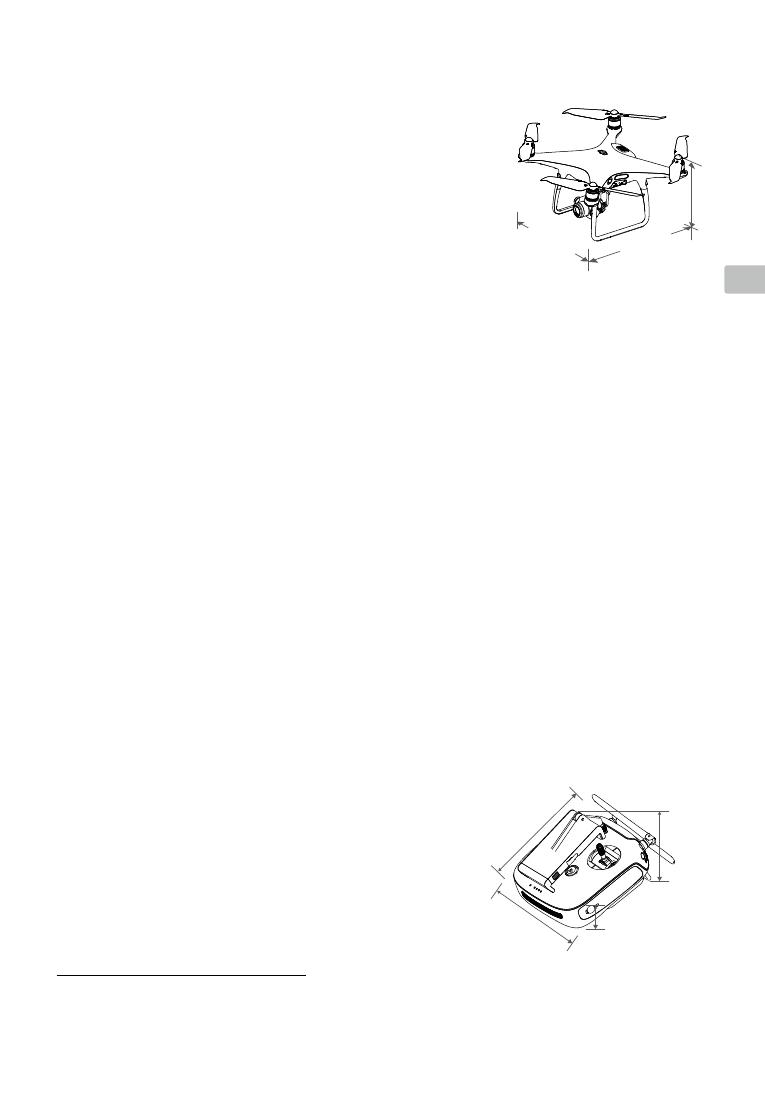
31
IT
Speciche
●Velivolo
Peso (batteria ed eliche incluse) 1375 g
Massima velocità di risalita Modalità S: 6 m/s; modalità P: 5 m/s
Massima velocità di discesa Modalità S: 4 m/s; modalità P: 3 m/s
Velocità massima 72 km/h (45 mph) (modalità S); 58 km/h (36 mph) (modalità A);
50 km/h (31 mph) (modalità P)
Quota massima di funzionamento sopra il
livello del mare 6.000 m (19.685 ft)
Durata massima di volo Circa 30 minuti
Temperatura di funzionamento Da 0 °C a 40 °C (da 32 °F a 104 °F)
GNSS GPS+GLONASS
Frequenza operativa 2,400 - 2,483 GHz e 5,725 - 5,850 GHz
Potenza del trasmettitore (EIRP) 2,4 GHz: ≤26 dBm (FCC); ≤20 dBm (CE); ≤20 dBm (SRRC)
5,8 GHz: ≤26 dBm (FCC); ≤14 dBm (CE); ≤26 dBm (SRRC)
Gamma di accuratezza del volo in
sospensione
Verticale: ±0,1 m (con posizionamento visivo); ±0,5 m (con posizionamento GPS)
Orizzontale: ±0,3 m (con posizionamento visivo); ±1,5 m (con posizionamento GPS)
●Gimbal
Intervallo controllabile Beccheggio: da -90° a +30°
●Sistema visivo
Intervallo di velocità ≤50 km/h (31 mph) a 2 m (6,6 piedi) sul suolo
Intervallo di altitudine 0 - 33 piedi (0 - 10 m)
Intervallo di funzionamento 0 - 33 piedi (0 - 10 m)
Intervallo di rilevamento degli ostacoli 2 - 98 piedi (0,7 - 30 m)
Ambiente operativo Superci con motivi chiari e illuminazione adeguata (> 15 lux)
●Sistema di rilevamento a infrarossi
Intervallo di rilevamento degli ostacoli 0,6 - 23 piedi (0,2 - 7 m)
Ambiente operativo Supercie con materiale a riessione diffusa, e riettività > 8% (come pareti, alberi, esseri umani, ecc.)
●Telecamera
Sensore 1'' CMOS; pixel effettivi: 20M
Obiettivo FOV (Field of View = campo visivo) 84°, 8.8 mm (formato equivalente 35 mm: 24 mm), f/2,8 - f/11, fuoco automatico a 1 m - ∞
Intervallo ISO Video: 100 - 3.200 (Auto); 100 - 6.400 (Manuale); Foto: 100 - 3.200 (Auto); 100 - 12.800 (Manuale)
Otturatore meccanico 8 - 1/2.000 s
Otturatore elettronico 8 - 1/8.000 s
Massima dimensione immagine Rapporto d'aspetto 3:2: 5.472×3.648; rapporto d'aspetto 4:3: 4.864×3.648; rapporto d'aspetto 16:9: 5.472×3.078
Modalità fotograa Single Shot
Scatti a rafca: 3/5/7/10/14 fotogrammi
Auto Exposure Bracketing (AEB): 3/5 fotogrammi nell'intervallo con 0,7 EV di deviazione
Intervallo: 2/3/5/7/10/15/30/60 s
Modalità di registrazione video H.265
●C4K: 4096×2160 24/25/30p
●4K: 3840×2160 24/25/30p
●2,7K: 2720×1530 24/25/3 0/48/50/60p
●FHD: 1920×1080 24/25/30/48/50/60/120p
●HD: 1280×720 24/25/30/48/50/60/120p
H.264
●C4K: 4096×2160 24/25/30/48/50/60p
●4K: 3840×2160 24/25/30/48/50/60p
●2,7K: 2720×1530 24/25/30/48/50/60p
●FHD: 1920×1080 24/25/30/48/50/60/120p
●HD: 1280×720 24/25/30/48/50/60/120p
Velocità di trasmissione per
memorizzazione video 100 Mbps
File system supportati FAT32 (≤ 32 GB); exFAT (> 32 GB)
Fotograe JPEG, RAW (DNG), JPEG + RAW
Video MP4/MOV (AVC/H.264; HEVC/H.265)
Schede SD supportate Micro SD, capacità massima: 128 GB. Classe 10 o UHS-1 nominale richiesta
Temperatura di funzionamento Da 0 °C a 40 °C (da 32 °F a 104 °F)
●Dispositivo di controllo remoto
Frequenza operativa 2,400 - 2,483 GHz e 5,725 - 5,850 GHz
Distanza massima di trasmissione
(sgombra e priva di interferenze)2,4GHz:10km(FCC);6km(CE);6km(SRRC)
5,8GHz:10km(FCC);6km(CE);6km(SRRC)
Temperatura di funzionamento Da 0 °C a 40 °C (da 32 °F a 104 °F)
Batteria 6000 mAh LiPo 2S
Potenza del trasmettitore (EIRP) 2,4 GHz: ≤26 dBm (FCC); ≤20 dBm (CE); ≤20 dBm (SRRC)
5,8 GHz: ≤26 dBm (FCC); ≤14 dBm (CE); ≤20 dBm (SRRC)
Tensione di funzionamento 1,2 A - 7,4 V
●Caricabatteria
Tensione 17,4 V
Potenza nominale 100 W
●Batteria di volo intelligente (PH4-5870mAh-15.2V)
Capacità 5870 mAh
Tensione 15,2 V
Tipo di batteria LiPo 4S
Energia 89,2 Wh
Peso netto 468 g
Intervallo temperatura di carica Da 5 °C a 40 °C (da 41 °F a 104 °F)
Massima potenza di carica 100 W
Per ulteriori informazioni, consultare il Manuale utente:
http://www.dji.com/phantom-4-pro-v2
※ Questi contenuti sono soggetti a modiche senza preavviso.
PHANTOM è un marchio registrato di DJI.
Copyright © 2021 DJI Tutti i diritti riservati.
28
9.
5
mm
196 mm
289.5 mm
1
8
2
m
m
136 mm
71 mm
172 mm


















































